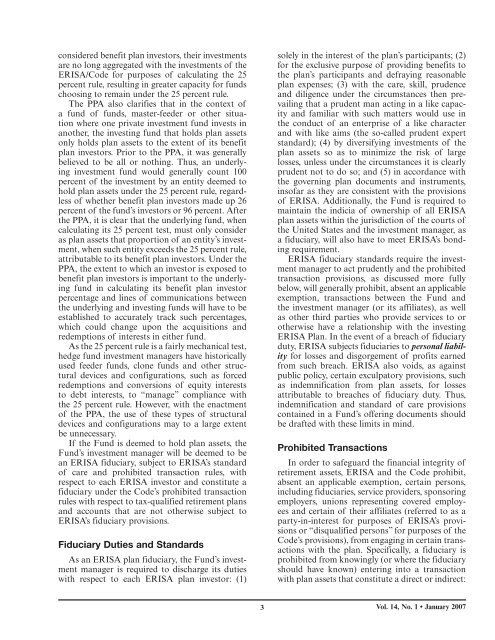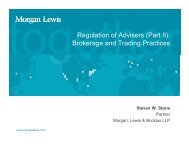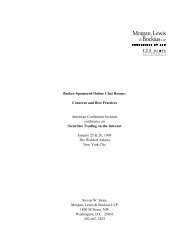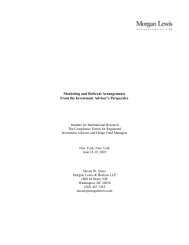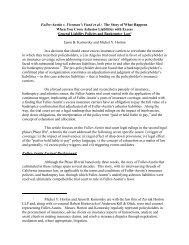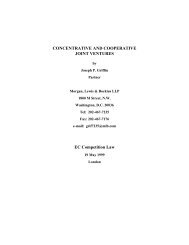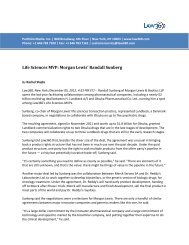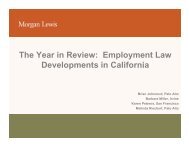What to Do if Your Fund Becomes Subject to ERISA - Morgan, Lewis ...
What to Do if Your Fund Becomes Subject to ERISA - Morgan, Lewis ...
What to Do if Your Fund Becomes Subject to ERISA - Morgan, Lewis ...
You also want an ePaper? Increase the reach of your titles
YUMPU automatically turns print PDFs into web optimized ePapers that Google loves.
considered benefit plan inves<strong>to</strong>rs, their investments<br />
are no long aggregated with the investments of the<br />
<strong>ERISA</strong>/Code for purposes of calculating the 25<br />
percent rule, resulting in greater capacity for funds<br />
choosing <strong>to</strong> remain under the 25 percent rule.<br />
The PPA also clar<strong>if</strong>ies that in the context of<br />
a fund of funds, master-feeder or other situation<br />
where one private investment fund invests in<br />
another, the investing fund that holds plan assets<br />
only holds plan assets <strong>to</strong> the extent of its benefit<br />
plan inves<strong>to</strong>rs. Prior <strong>to</strong> the PPA, it was generally<br />
believed <strong>to</strong> be all or nothing. Thus, an underlying<br />
investment fund would generally count 100<br />
percent of the investment by an entity deemed <strong>to</strong><br />
hold plan assets under the 25 percent rule, regardless<br />
of whether benefit plan inves<strong>to</strong>rs made up 26<br />
percent of the fund’s inves<strong>to</strong>rs or 96 percent. After<br />
the PPA, it is clear that the underlying fund, when<br />
calculating its 25 percent test, must only consider<br />
as plan assets that proportion of an entity’s investment,<br />
when such entity exceeds the 25 percent rule,<br />
attributable <strong>to</strong> its benefit plan inves<strong>to</strong>rs. Under the<br />
PPA, the extent <strong>to</strong> which an inves<strong>to</strong>r is exposed <strong>to</strong><br />
benefit plan inves<strong>to</strong>rs is important <strong>to</strong> the underlying<br />
fund in calculating its benefit plan inves<strong>to</strong>r<br />
percentage and lines of communications between<br />
the underlying and investing funds will have <strong>to</strong> be<br />
established <strong>to</strong> accurately track such percentages,<br />
which could change upon the acquisitions and<br />
redemptions of interests in either fund.<br />
As the 25 percent rule is a fairly mechanical test,<br />
hedge fund investment managers have his<strong>to</strong>rically<br />
used feeder funds, clone funds and other structural<br />
devices and configurations, such as forced<br />
redemptions and conversions of equity interests<br />
<strong>to</strong> debt interests, <strong>to</strong> “manage” compliance with<br />
the 25 percent rule. However, with the enactment<br />
of the PPA, the use of these types of structural<br />
devices and configurations may <strong>to</strong> a large extent<br />
be unnecessary.<br />
If the <strong>Fund</strong> is deemed <strong>to</strong> hold plan assets, the<br />
<strong>Fund</strong>’s investment manager will be deemed <strong>to</strong> be<br />
an <strong>ERISA</strong> fiduciary, subject <strong>to</strong> <strong>ERISA</strong>’s standard<br />
of care and prohibited transaction rules, with<br />
respect <strong>to</strong> each <strong>ERISA</strong> inves<strong>to</strong>r and constitute a<br />
fiduciary under the Code’s prohibited transaction<br />
rules with respect <strong>to</strong> tax-qual<strong>if</strong>ied retirement plans<br />
and accounts that are not otherwise subject <strong>to</strong><br />
<strong>ERISA</strong>’s fiduciary provisions.<br />
Fiduciary Duties and Standards<br />
As an <strong>ERISA</strong> plan fiduciary, the <strong>Fund</strong>’s investment<br />
manager is required <strong>to</strong> discharge its duties<br />
with respect <strong>to</strong> each <strong>ERISA</strong> plan inves<strong>to</strong>r: (1)<br />
solely in the interest of the plan’s participants; (2)<br />
for the exclusive purpose of providing benefits <strong>to</strong><br />
the plan’s participants and defraying reasonable<br />
plan expenses; (3) with the care, skill, prudence<br />
and diligence under the circumstances then prevailing<br />
that a prudent man acting in a like capacity<br />
and familiar with such matters would use in<br />
the conduct of an enterprise of a like character<br />
and with like aims (the so-called prudent expert<br />
standard); (4) by divers<strong>if</strong>ying investments of the<br />
plan assets so as <strong>to</strong> minimize the risk of large<br />
losses, unless under the circumstances it is clearly<br />
prudent not <strong>to</strong> do so; and (5) in accordance with<br />
the governing plan documents and instruments,<br />
insofar as they are consistent with the provisions<br />
of <strong>ERISA</strong>. Additionally, the <strong>Fund</strong> is required <strong>to</strong><br />
maintain the indicia of ownership of all <strong>ERISA</strong><br />
plan assets within the jurisdiction of the courts of<br />
the United States and the investment manager, as<br />
a fiduciary, will also have <strong>to</strong> meet <strong>ERISA</strong>’s bonding<br />
requirement.<br />
<strong>ERISA</strong> fiduciary standards require the investment<br />
manager <strong>to</strong> act prudently and the prohibited<br />
transaction provisions, as discussed more fully<br />
below, will generally prohibit, absent an applicable<br />
exemption, transactions between the <strong>Fund</strong> and<br />
the investment manager (or its affiliates), as well<br />
as other third parties who provide services <strong>to</strong> or<br />
otherwise have a relationship with the investing<br />
<strong>ERISA</strong> Plan. In the event of a breach of fiduciary<br />
duty, <strong>ERISA</strong> subjects fiduciaries <strong>to</strong> personal liability<br />
for losses and disgorgement of profits earned<br />
from such breach. <strong>ERISA</strong> also voids, as against<br />
public policy, certain exculpa<strong>to</strong>ry provisions, such<br />
as indemn<strong>if</strong>ication from plan assets, for losses<br />
attributable <strong>to</strong> breaches of fiduciary duty. Thus,<br />
indemn<strong>if</strong>ication and standard of care provisions<br />
contained in a <strong>Fund</strong>’s offering documents should<br />
be drafted with these limits in mind.<br />
Prohibited Transactions<br />
In order <strong>to</strong> safeguard the financial integrity of<br />
retirement assets, <strong>ERISA</strong> and the Code prohibit,<br />
absent an applicable exemption, certain persons,<br />
including fiduciaries, service providers, sponsoring<br />
employers, unions representing covered employees<br />
and certain of their affiliates (referred <strong>to</strong> as a<br />
party-in-interest for purposes of <strong>ERISA</strong>’s provisions<br />
or “disqual<strong>if</strong>ied persons” for purposes of the<br />
Code’s provisions), from engaging in certain transactions<br />
with the plan. Spec<strong>if</strong>ically, a fiduciary is<br />
prohibited from knowingly (or where the fiduciary<br />
should have known) entering in<strong>to</strong> a transaction<br />
with plan assets that constitute a direct or indirect:<br />
Vol. 14, No. 1 • January 2007


